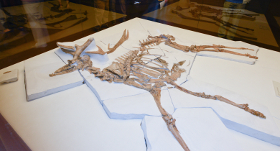In Valle Borlezza, close to the settlement, Sovere, and a lake, Iseo, the paleontological research activities of the museum have enabled recovery of a magnificent specimen of Cervus acoronatus.
This deer species died out some hundreds of thousands of years ago. This truly amazing fossilized adult stag features an imposing set of antlers endowed with many points. The fossil was discovered in sediments. The stag was in a reclining position, and the anatomic parts were perfectly connected. It is a practically fully intact specimen in its original posture. We thus learn that the deer fell into a water pool during the winter. During the research campaign, another 1,500 paleontological findings were also discovered, mainly consisting of vegetable remains such as seeds, leaves and branches, but also including insects and the remains of small mammals. These items were all discovered in the fine sediments of an ancient lake which had dried up completely and which is also subject to erosion by the Borlezza stream, within a context known by geologists as Bacino di Pianico – Sèllere.
Research and geological study have provided unexpected insights into hills, lakes, glaciers, animals and forests, not only regarding life but also the climate and environment of the Middle Pleistocene epoch, about 720,000 years ago. In this room, the fossilized stag, with its reclining posture in its original stone matrix, is given pride of place. It is stored in the immaterial atmosphere of a crystal glass cabinet. Visitors will have the sensation they have travelled back in time. This long story is told with images and film footage documenting the extremely delicate work stages undertaken by the museum’s staff for over ten years. The first stage was discovery. Careful excavation then took place. Step by step, we learn of the various stages leading up to dehydration, preparation and consolidation of the fossilized skeletal parts and blocks of stony material.




